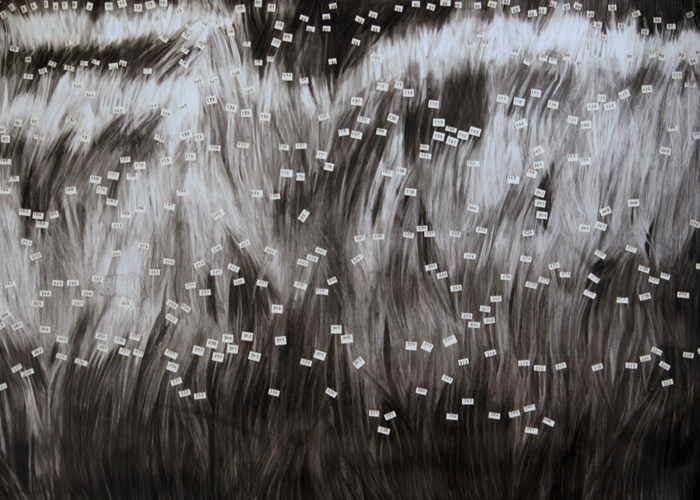il prato infinito
work in progress 16 disegni a matita su carta e collage, terra e prato
dimensioni 200x280 cm
2010-2012 presso Galleria Cart- Monza
Contare quanti fili d'erba ci sono, di quali specie, quanto fitti e come distribuiti. In base a questo calcolo si arriverà a una
conoscenza statistica del prato, stabilita la quale... Ma contare i fili d'erba è inutile, non s'arriverà mai a saperne il numero. Un
prato non ha confini netti, c'è un orlo dove l'erba cessa di crescere ma ancora qualche filo sparso ne spunta più in là, poi una
zolla verde fitta, poi una striscia più rada: fanno ancora parte del prato o no? Altrove il sottobosco entra nel prato: non si può
dire cos'è prato e cos'è cespuglio. Ma pure là dove non c'è che erba, non si sa mai a che punto si può smettere di contare: tra
pianticella e pianticella c'è sempre un germoglio di fogliolina che affiora appena dalla terra e ha per radice un pelo bianco che
quasi non si vede; un minuto fa si poteva trascurarla ma tra poco dovremo contare anche lei. Intanto altri due fili che poco fa
sembravano appena un po' giallini ecco che ora sono definitivamente appassiti e sarebbero da cancellare dal conto. Poi ci sono
le frazioni di fili d'erba, troncati a metà, o rasi al suolo, o lacerati lungo le nervature, le foglioline che hanno perso un lobo... I
decimali sommati non fanno un numero intero, restano una minuta devastazione erbacea, in parte ancora vivente, in parte già
poltiglia, alimento d'altre piante, humus…[...]Palomar è già passato a un altro corso di pensieri: è "il prato" ciò che noi
vediamo oppure vediamo un'erba più un'erba più un'erba...? Quello che noi diciamo "vedere il prato" è solo un effetto dei nostri
sensi approssimativi e grossolani; un insieme esiste solo in quanto formato da elementi distinti. Non è il caso di contarli, il
numero non importa; quel che importa è afferrare in un solo colpo d'occhio le singole pianticelle una per una, nelle loro
particolarità e differenze. E non solamente vederle: pensarle. Invece di pensare "prato", pensare quel gambo con due foglie di
trifoglio, quella foglia lanceolata un po' ingobbita, quel corimbo sottile...Palomar s'è distratto, non strappa più le erbacce, non
pensa più al prato: pensa all'universo. Sta provando ad applicare all'universo tutto quello che ha pensato del prato. L'universo
come cosmo regolare e ordinato o come proliferazione caotica. L'universo forse finito ma innumerabile, instabile nei suoi
confini, che apre entro di sé altri universi. L'universo, insieme di corpi celesti, nebulose, pulviscolo, campi di forze,
intersezioni di campi, insiemi di insiemi...
Count how many blades of grass there are, what species, how thick, how distributed.
On the basis of this calculation you would arrive at a statistical knowledge of the
lawn. But counting the blades of grass is futile: you would never learn their number
because a lawn does not have precise boundaries: even over the limit of it, it is always
possible to find a few blades coming out, then an area when the grass becomes
thicker, then just a few blades again…but aren’t they still part of the lawn? Elsewhere,
the bushes mix with the grass and it is impossible to tell where the lawn ends and the
underwood begins. But even when there seems to be no grass at all, we cannot stop
counting: among the bushes there is always some green leaf coming out or some small
root that now it is hard to see but that soon will grow and we will have to count it.
Meanwhile other blades that just a few minutes ago seemed a bit yellow are now dead
and should be left out from the count. Furthermore there are blades that are cut in half
or down to the root or broken along the nervatures, and even small leaves that lost one
side…the decimals do not make an integer; they remain a minute grassy devastation,
in part still alive, in part already pulp, food for other plants, humus …
[..]Then Mr Palomar changed the order of ideas and asked himself: is it the lawn what
we see, or is it some grass plus other grass plus other grass more…? What we call “to
see the lawn” is just the effect of the use of our rough and crude senses; a collection
exists just as a collection of different elements. It does not matter how much elements
there are, the important thing is to catch, at a glance, all the single plants, one by
one, in their own characteristics and differences. And the important thing is not just
to see them but to think about them; so, instead of thinking about “the lawn” it is
important to think about, for example, that single stalk with two clover’s leaves, that
lanceolate leaf bending a bit, that subtle corymb… Mr. Palomar's mind has wandered,
he has stopped pulling up weeds. He no longer thinks of the lawn: he thinks of the
universe. He is trying to apply to the universe everything he has thought about the
lawn. The universe as regular and ordered cosmos or as chaotic proliferation. The
universe perhaps finite but countless, unstable within its borders, which discloses
other universes within itself. The universe, collection of celestial bodies, nebulas, fine
dust, force fields, intersections of fields, collections of collections…
Italo Calvino






